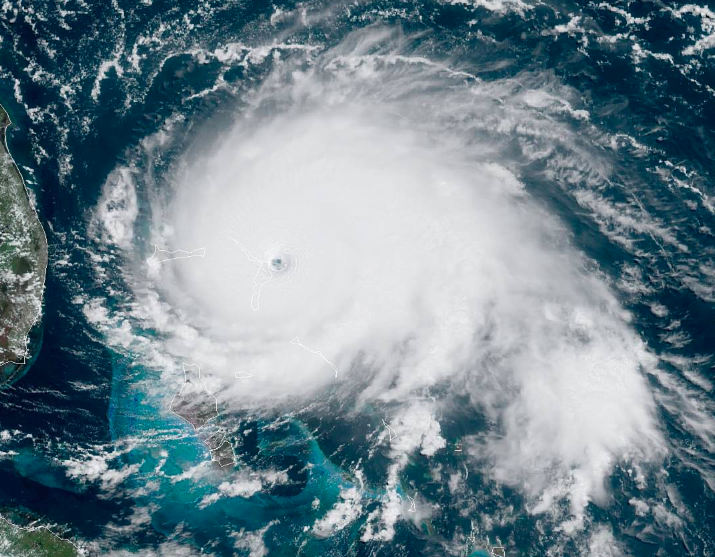
Despite having been downgraded from a fierce Category-5 storm to a Category-2, hurricane Dorian had stalled over the northern Bahamas for over 36 hours–extremely unusual behavior for a tropical storm–killing at least nine people and destroying tens of thousands of homes, causing “unprecedented and extensive” destruction, according to Bahamian Prime Minister Hubert Minnis.
Having been trapped between two high pressure systems, a Bermuda high in the mid-Atlantic and another in the Caribbean just north of Mexico’s Yucatan peninsula, Dorian began tracking northeast along the coast when it began to move again late on Tuesday, and is expected to slowly make its way up to the Georgia and South Carolina coasts Wednesday night, and the North Carolina coast late Thursday, according to the National Hurricane Center.
Evacuation orders have been issued for numerous counties along the coasts of Florida, Georgia and South Carolina, along with hurricane and tropical storm alerts issued for other regions across the same states. Seven have already died on the Bahamian Abaco Islands, where Dorian first struck as a category-5 storm on September 1, along with two other people killed, one in Puerto Rico and another in Florida.
By the morning of September 2, the Grand Bahama International Airport was under six feet (two meters) of water, inundated by a storm surge estimated to be 20 to 25 feet (6.1 to 7.6 meters) high. As many as 13,000 houses, or about 45 percent of the homes in Grand Bahama and Abaco, were damaged or destroyed, along with fears that seawater has contaminated water wells, prompting an urgent call for clean water for over 62,000 people.
Dorian is the strongest hurricane on record to strike the Bahamas since record-keeping began in 1851, with sustained winds of 185 mph (295 km/h) at its peak. The storm also has the highest sustained wind speeds of any Atlantic hurricane recorded as far north as Dorian’s latitude on record, and is tied with the 1935 Labor Day hurricane for the highest sustained winds at landfall in an Atlantic hurricane. Dorian is also one of only two Category-5 hurricanes to make landfall on the Abaco Islands, the other having occurred in 1932, and is the only such storm on record to have ever struck Grand Bahama.
Subscribers, to watch the subscriber version of the video, first log in then click on Dreamland Subscriber-Only Video Podcast link.
Subscribers only?
I’m in Florida. Yes, Dorian was headed, by all forecasting paths, west thru Palm Beach , including Pres. Trump’s housing [don’t know if that had anything to do with it]. Dorian not only stalled to 1 MPH, it turned 90 degrees suddenly. That seems impossible. And the northward path had small zigzags as if it was difficult to keep it straight. All of this appears to indicate HAARP weather control.
Since we’ve posted the article, Dorian has re-strengthened to a Category-3 storm, and is getting uncomfortably close to South Carolina’s coast. For those potentially affected, take appropriate measures: it mightn’t be the strongest storm, but it’s a slow-moving soaker. Tornado warnings have also been issued for parts of both Carolinas.
Tragically, 60 percent of the island of Grand Bahama is under water, a result of it being sandwiched between two high-pressure systems that kept it immobile over warmer-than-average waters:
https://www.theweathernetwork.com/ca/news/article/shocking-satellite-images-show-grand-bahama-before-and-after-dorian
Yes, all kinds of anomalies, oddities.
Definitely Weather warfare.
Weather warfare indeed: decades ago the energy sector decided it was worthwhile to conduct a prolonged first strike against the environment in the name of profit, aided and abetted by major governments around the world. And now, nature is retaliating, in the form of violent weather that is intended to restore equilibrium from the imbalance that this ongoing onslaught has caused.
I’m talking about global warming, of course. HAARP, as near as I can tell, isn’t capable of proper weather modification, especially on the scale of being able to steer something as powerful as a hurricane–the array is only capable of 0.000000018 percent of the output of a hurricane like Dorian. To put that in perspective, the two hundred trillion watts a major hurricane puts out is the equivalent of a 30-megaton nuke being detonated *every hour* over the course of the storm’s weeks-long lifespan.
Most importantly, there has also been a conspicuous absence of asymmetric heating effects along Dorian’s path, an effect that would be required to steer a powerful storm. The combination of a high-pressure system sandwich, global warming and northeast jet stream are, however, evident, and are the most likely culprit.
Besides, why would the University of Alaska Fairbanks (HAARP’s current owner/operator) see fit to obliterate the Bahamas in such a horrible fashion? If HAARP was actually capable of such fine control over a Cat-5 hurricane, they would have directed it out over the middle of the Atlantic where it would have caused virtually no damage.
looks like DARPA responded to DT’s request to keep Dorian pushed back with their EMP’s so it wouldn’t come near his Florida properties. The resultant suffering of the Bahamanians is beyond cruel.
What do you mean cruel they did the best they could to steer it away from the bahamas it just got the very nothern most island and completely missed florida what do you think would have been the outcome if dorian buzz sawed thru florida then hit the gulf with its 90 degree water that would have bankrupted the economy.